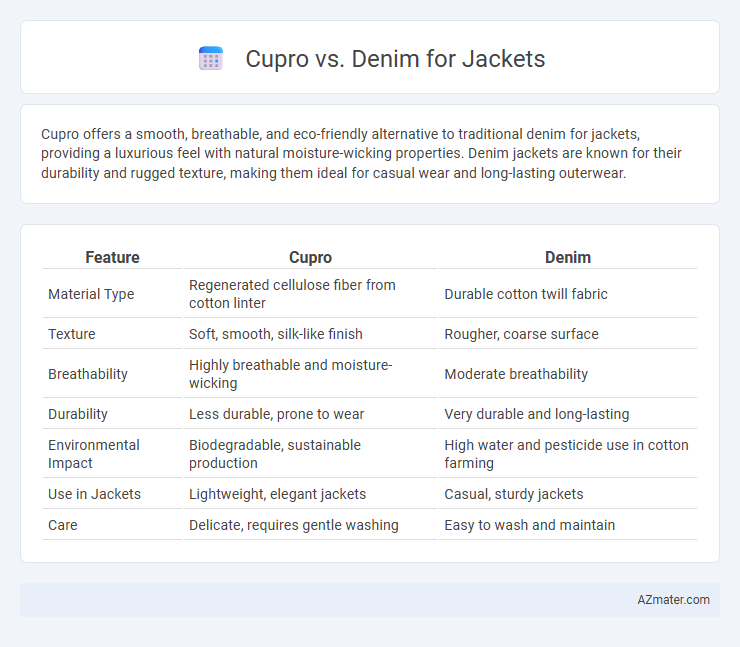Cupro offers a smooth, breathable, and eco-friendly alternative to traditional denim for jackets, providing a luxurious feel with natural moisture-wicking properties. Denim jackets are known for their durability and rugged texture, making them ideal for casual wear and long-lasting outerwear.
Table of Comparison
| Feature | Cupro | Denim |
|---|---|---|
| Material Type | Regenerated cellulose fiber from cotton linter | Durable cotton twill fabric |
| Texture | Soft, smooth, silk-like finish | Rougher, coarse surface |
| Breathability | Highly breathable and moisture-wicking | Moderate breathability |
| Durability | Less durable, prone to wear | Very durable and long-lasting |
| Environmental Impact | Biodegradable, sustainable production | High water and pesticide use in cotton farming |
| Use in Jackets | Lightweight, elegant jackets | Casual, sturdy jackets |
| Care | Delicate, requires gentle washing | Easy to wash and maintain |
Introduction to Cupro and Denim
Cupro is a regenerated cellulose fiber derived from cotton waste, known for its silky texture, breathability, and eco-friendly production, making it a luxurious alternative in jacket fabrics. Denim, traditionally made from durable cotton twill, boasts a rugged construction and timeless appeal, favored for its strength and versatility in casual and workwear jackets. Understanding the distinct properties of cupro and denim helps in selecting jackets that balance comfort, sustainability, and style.
What is Cupro?
Cupro is a regenerated cellulose fiber derived from cotton linter, known for its silky texture, breathability, and moisture-wicking properties, making it an ideal fabric for lightweight jackets. Unlike denim, which is a sturdy cotton twill weave, Cupro offers a smooth, luxurious feel that drapes well and resists static cling. Jackets made from Cupro provide enhanced comfort and elegance, suitable for transitional seasons or layering with casual and formal attire.
What is Denim?
Denim is a durable cotton twill fabric characterized by its diagonal ribbing and typically dyed with indigo to create a distinctive blue color, making it a popular choice for jackets due to its strength and rugged aesthetic. This heavyweight textile offers excellent abrasion resistance and evolves with wear, developing a unique patina that reflects individual style. Denim jackets are valued for their versatility and timeless appeal, combining functionality with classic fashion elements.
Fabric Composition and Texture
Cupro fabric is derived from regenerated cellulose fibers, typically sourced from cotton linter, offering a silky smooth texture that drapes elegantly. Denim is traditionally woven from 100% cotton fibers, characterized by a rugged, textured surface with a distinctive twill weave pattern providing durability. Both materials serve different aesthetic and functional purposes in jackets, with Cupro favoring softness and breathability, while Denim emphasizes strength and a casual, structured look.
Durability and Strength Comparison
Cupro jackets offer a smooth, silk-like texture but generally lack the durability and strength that denim provides. Denim, made from tightly woven cotton twill, is well-known for its robust wear resistance and long-lasting performance, making it ideal for jackets requiring heavy-duty use. For longevity and toughness, denim outperforms cupro in abrasion resistance and structural integrity.
Comfort and Breathability
Cupro jackets offer superior breathability due to their natural cellulose fibers, making them lightweight and moisture-wicking, ideal for maintaining comfort in warmer weather. Denim jackets, made from sturdy cotton twill, provide durability and moderate breathability but can feel heavier and less breathable in hot conditions. For all-day comfort and better airflow, cupro is preferred, while denim suits those seeking a rugged, structured fit with classic style.
Sustainability and Eco-Friendliness
Cupro jackets offer superior sustainability compared to denim, as Cupro is made from regenerated cellulose fibers sourced from cotton linter, a byproduct of cotton production, which minimizes waste and reduces reliance on virgin materials. Denim, typically made from 100% cotton, involves resource-intensive farming practices that contribute to significant water consumption and pesticide use, impacting eco-friendliness negatively. The biodegradable nature of Cupro and its lower environmental footprint in production make it an increasingly preferred choice for eco-conscious fashion brands focused on sustainable outerwear.
Style and Aesthetic Appeal
Cupro jackets offer a smooth, silky texture with a subtle sheen that enhances elegance and sophistication, making them ideal for refined, fashion-forward looks. Denim jackets provide a rugged, casual appeal with a textured, matte finish that suits versatile streetwear and classic Americana styles. Both materials cater to distinct aesthetics: cupro aligns with polished, modern ensembles, while denim anchors timeless, laid-back outfits.
Maintenance and Care Requirements
Cupro jackets require gentle washing, preferably hand wash or delicate machine cycles, and air drying to maintain fabric integrity and softness, with minimal ironing needed due to its smooth texture. Denim jackets are more durable but benefit from infrequent washing to preserve color and shape, typically washed inside out in cold water and line dried; occasional light ironing or steaming helps maintain a crisp look. Both fabrics demand careful spot cleaning to avoid damage, with cupro being more sensitive to heat and abrasion compared to the robust nature of denim.
Choosing the Right Fabric for Your Jacket
Cupro offers a smooth, silky texture with excellent breathability and moisture-wicking properties, making it ideal for lightweight, breathable jackets in warm climates. Denim provides durability, structure, and a classic rugged appearance suited for casual and everyday wear, with its heavyweight cotton twill fabric offering long-lasting wear. Selecting between cupro and denim depends on your preference for comfort versus durability, where cupro excels in softness and breathability while denim offers tough, resilient fabric for cooler weather.

Infographic: Cupro vs Denim for Jacket
 azmater.com
azmater.com